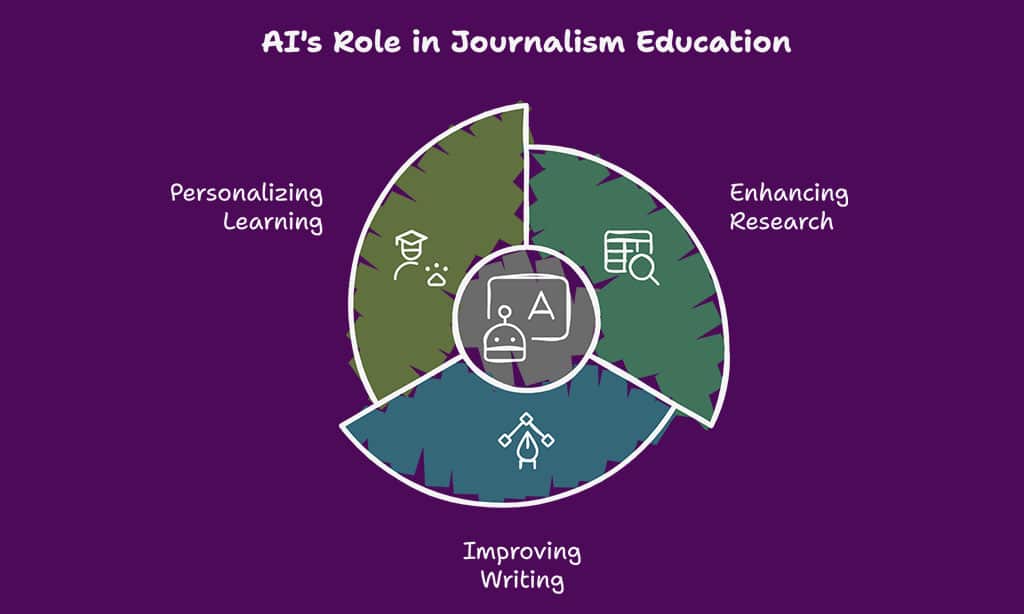Artificial intelligence (AI) is revolutionizing the world of journalism, transforming how news is gathered, analyzed, and reported. With its ability to process vast amounts of data, generate content, and enhance storytelling, AI in journalism education is becoming an essential tool for training the next generation of journalists.
Journalism schools and media institutions worldwide are adopting AI-driven platforms to enhance learning experiences, allowing students to engage with real-world reporting challenges in a digital age.
From automated content creation to AI-driven analytics, journalism students must understand the evolving landscape shaped by this technology. By integrating AI tools, journalism education can foster more efficient workflows, data-driven reporting, and immersive storytelling techniques.
In this article, we explore four key applications of AI in journalism education, shedding light on how these innovations are equipping students with advanced skills and preparing them for an AI-driven newsroom.
The Role of AI in Journalism Education
AI in journalism education is transforming how aspiring journalists acquire and apply essential reporting skills. From AI-driven content generation to data analysis, students are gaining hands-on experience with tools that redefine traditional journalistic practices. As media landscapes become increasingly digital, AI integration ensures that journalism education remains relevant and future-proof.
How AI is Reshaping Journalism Training
AI in journalism education is shifting traditional training methods by introducing cutting-edge tools that assist in news reporting, data analysis, and multimedia storytelling. Journalism schools are leveraging AI-powered programs to help students develop investigative journalism skills, understand audience behavior, and create compelling digital content. AI-enhanced curricula provide future journalists with hands-on exposure to automated writing, sentiment analysis, and ethical AI practices.
Key Impact Areas:
| AI Application | Benefit to Journalism Students |
| AI-driven research tools | Accelerate data collection and analysis |
| Automated news writing | Enhances speed and efficiency in reporting |
| AI in visual storytelling | Improves audience engagement with data-driven graphics |
| AI-powered fact-checking | Strengthens journalistic credibility and accuracy |
Benefits of AI in Journalism Learning Environments
As journalism evolves in the digital era, AI is playing a crucial role in enhancing the learning process for students. AI in journalism education provides learners with access to cutting-edge tools that streamline research, improve writing quality, and personalize learning experiences. By leveraging AI-powered platforms, students can develop essential skills that align with the demands of modern newsrooms.
Enhancing Research and Data Analysis
- AI-driven tools help students analyze vast amounts of data efficiently, making investigative journalism more accessible.
- AI-powered algorithms detect trends and patterns from large datasets, aiding in more precise reporting.
- Fact-checking tools powered by AI enable students to verify information instantly, reducing misinformation risks.
Improving Writing and Content Generation
- AI-generated content provides students with templates for news writing, helping them structure their articles better.
- Writing assistants like Grammarly and Hemingway Editor refine journalistic writing by improving grammar, readability, and coherence.
- AI-powered translation tools enable multilingual reporting, allowing students to engage with global audiences effectively.
Personalizing Learning for Journalism Students
- AI-powered tutors offer customized learning experiences based on a student’s progress and challenges.
- Adaptive learning platforms analyze student engagement and provide tailored content recommendations.
- AI grading tools provide instant feedback on assignments, enabling students to improve their work efficiently.
4 Key Applications of AI in Journalism Education
The integration of AI in journalism education is not just about automation; it’s about redefining how students engage with content creation, data interpretation, and ethical reporting.
AI-driven tools are empowering journalism students to produce accurate, compelling, and data-backed news stories with greater efficiency. By leveraging AI, students can experiment with innovative storytelling formats and develop a deep understanding of how technology shapes modern media.
1. AI-Powered Content Generation and Editing
AI-powered journalism tools like GPT-based content generators assist students in creating drafts quickly. These tools help aspiring journalists learn efficient storytelling techniques and reduce the time spent on repetitive writing tasks. AI-generated news is being increasingly adopted by major publications like The Associated Press and Forbes, demonstrating the industry’s reliance on automation for efficiency.
| Tool | Function |
| GPT-based content generators | Assists in writing news drafts |
| AI-powered headline generators | Suggests engaging headlines |
| Automated summary tools | Condenses long articles into key points |
AI-Assisted Proofreading and Fact-Checking
- AI-driven grammar checkers such as Grammarly refine journalistic writing and eliminate errors.
- Fact-checking AI tools like Full Fact and Google Fact Check Explorer help verify sources instantly, ensuring accurate reporting.
- Automated plagiarism detection tools such as Copyscape and Turnitin ensure originality in journalistic content.
2. Data-Driven Journalism and Analytics
- AI-powered tools analyze public records and detect patterns in financial data, making investigative journalism more robust.
- AI assists in uncovering corruption by processing vast datasets, as seen in projects like the Panama Papers investigation.
- Machine learning algorithms highlight hidden connections between people, organizations, and events, aiding investigative storytelling.
| AI Application | Use in Journalism |
| AI-driven analytics | Identifies patterns in large datasets |
| Machine learning | Uncovers relationships in investigative journalism |
| AI fraud detection | Analyzes financial transactions for fraud exposure |
Sentiment Analysis and Audience Insights
- AI analyzes reader engagement and feedback, allowing students to craft stories that resonate with their target audience.
- Sentiment analysis tools measure audience reactions to news topics, helping journalists understand public opinion.
- AI-powered data insights guide content personalization and distribution, optimizing engagement strategies.
3. AI for Multimedia and Visual Storytelling
- AI-driven design tools like Canva and Adobe Sensei create engaging visuals for news stories.
- Automated video editing platforms enhance multimedia journalism projects by simplifying the production process.
- AI-generated infographics help simplify complex data visualization, improving audience comprehension.
Enhancing Reporting with AI-Driven Transcriptions
- AI-powered transcription tools like Otter.ai convert interviews into text within minutes, streamlining workflow.
- Saves time and improves accuracy in news reporting, especially for live events and long-form interviews.
- Real-time transcription tools assist in producing accessible content for a diverse audience, including those with hearing impairments.
4. AI in Journalism Ethics and Media Literacy
- AI tools analyze sources to combat fake news and misinformation, an essential skill in journalism education.
- Machine learning algorithms flag misleading content, ensuring students develop critical media literacy skills.
- AI-driven fact-checking bots, like those used by Facebook and Twitter, help students understand the role of AI in digital journalism.
Ethical Implications of AI in Newsrooms
- AI-driven news requires responsible usage to prevent bias in automated reporting.
- Ethical journalism must balance AI automation with human oversight to maintain credibility.
- Journalism students learn to navigate the ethical challenges of AI in reporting, such as transparency, bias mitigation, and accountability.
Challenges and Future of AI in Journalism Education
As AI continues to shape journalism education, it presents both opportunities and challenges. While AI tools enhance efficiency and accuracy, they also raise concerns regarding bias, ethics, and the role of human creativity in journalism.
Addressing these challenges is essential to ensure that AI serves as a complement rather than a replacement for traditional journalistic practices.
Overcoming Bias and Ethical Concerns
- AI systems can inherit biases from their training data, requiring careful oversight.
- Journalism students must learn to recognize and correct algorithmic bias in AI-generated content.
- Institutions should integrate AI ethics courses in journalism curricula to address responsible AI usage.
Balancing AI and Human Creativity in Journalism
- AI can generate data-driven stories, but human creativity remains vital for compelling storytelling.
- Journalism education should emphasize critical thinking and investigative techniques alongside AI use.
- AI should be used as an aid, not a replacement, for traditional journalistic practices.
The Future of AI-Driven Journalism Training
- AI will continue to shape journalism education through interactive learning tools like AI-powered VR news simulations.
- Virtual reality and AI-driven simulations will enhance journalism training, offering students hands-on experience in real-world scenarios.
- Future journalists must adapt to AI-driven content production while upholding ethical standards in digital reporting.
Takeaways
AI in journalism education is no longer a futuristic concept—it is an essential component of modern media training. By integrating AI-powered tools, journalism schools can better prepare students for the evolving news industry.
From AI-generated content to data-driven storytelling, these applications enhance efficiency, accuracy, and engagement in journalism. However, ethical considerations and human oversight remain crucial in maintaining journalistic integrity.
As AI continues to advance, journalism educators and students must embrace innovation while upholding the core values of journalism: truth, accuracy, and responsible reporting. The future of journalism lies in the synergy between AI and human expertise, ensuring that the next generation of journalists is equipped with the skills to navigate the digital landscape effectively.









































